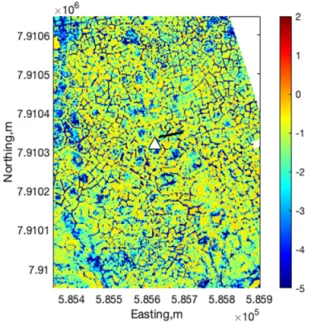Multi-scale, multi-type Arctic tundra datasets enabled the submeter estimation of daytime average net ecosystem exchanges.
Land-atmosphere carbon exchange is known to be extremely heterogeneous in Arctic ice-wedge polygonal tundra regions, which cover much of the high-Arctic. Mapping net ecosystem exchange (NEE)—at the resolution that resolves microtopography—is needed to quantify the overall NEE as well as to understand the potential effects of geomorphological changes on NEE associated with permafrost thaw. Although there are many new remote sensing and sensor technologies, it has been a challenge on integrating all the relevant measurements. In this study, a Kalman filter-based method was developed to estimate the spatiotemporal dynamics of daytime average NEE (NEEday) at 0.5-m resolution over a 550 m by 700 m study site. The authors integrated multi-scale, multi-type datasets, including normalized difference vegetation indices (NDVIs) obtained from a novel automated mobile sensor system (or tram system) and a greenness index map obtained from airborne imagery. We took advantage of the significant correlations between NDVI and NEEday identified based on flux chamber measurements. The weighted average of the estimated NEEday within the flux-tower footprint agreed with the flux tower data in term of its seasonal dynamics. The spatial variability of the growing season average NEEday was evaluated, as a function of polygon geomorphic classes; i.e., the combination of polygon types—which are known to present different degradation stages associated with permafrost thaw—and microtopographic features (i.e., troughs, centers and rims). This study suggests the importance of considering microtopographic features and their spatial coverage in computing spatially aggregated carbon exchange.
Citation: Wainwright, H. M., R. Oktem, B. Dafflon, S. Dengel, J. B. Curtis, M. S. Torn, J. Cherry, and S. S. Hubbard. 2021. “High-resolution spatio-temporal estimation of net ecosystem exchange in ice-wedge polygon tundra using In situ sensors and remote sensing data.” Land 10: 722. https://doi.org/10.3390/land10070722.


